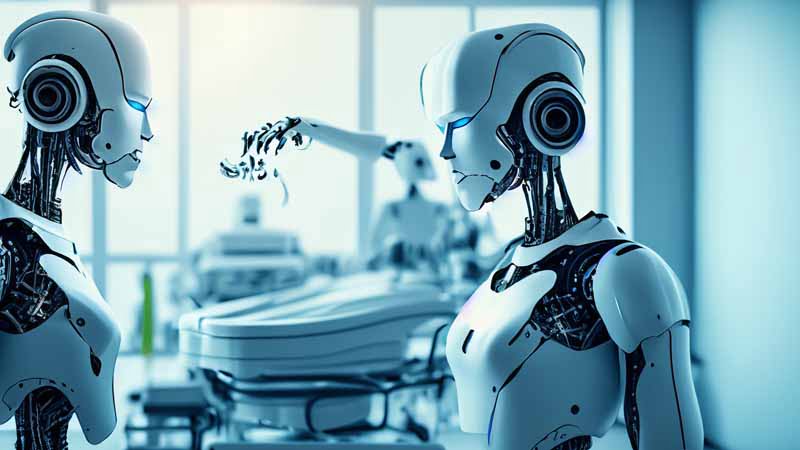In this article we will discusses how in future AI can reshape industries, from healthcare and finance to creative arts and scientific research, highlighting its potential for revolutionizing problem-solving, co-creation, and accelerating discoveries.
Table of Contents
AI is set to reshape various aspects of our world. In the realm of drug discovery, it will delve into how AI is poised to revolutionize pharmaceutical research, accelerating the identification of potential drug candidates. The article will then shift its focus to smart cities, where AI will pioneer urban transformation, optimizing traffic flow, sustainability, and more. Furthermore, it will delve into ocean exploration, highlighting how AI-powered underwater vehicles will unveil the mysteries of the deep sea. The piece will also discuss how AI is poised to transform sports analysis, offering insights into player performance and strategy optimization. With AI’s limitless potential, the article will illuminate a future where technology and innovation unite to create groundbreaking possibilities across various domains.
Drug Discovery: AI Revolutionizing Pharmaceutical Research
The process of drug discovery has historically been a time-consuming, costly, and often unpredictable journey that involves extensive experimentation and clinical trials. However, the integration of AI in future into pharmaceutical research will revolutionrize this field by significantly accelerating the identification and development of new drugs. One key area where AI will make a profound impact is in simulating molecular interactions and predicting potential drug candidates. Here’s how AI is transforming drug discovery:
- Target Identification: AI algorithms analyze vast biological and genetic datasets to identify potential drug targets. By examining genetic information, protein structures, and disease pathways, AI can pinpoint specific molecules or proteins that play a crucial role in a disease, making them attractive candidates for drug development.
- Virtual Screening: AI-powered models screen databases of chemical compounds to identify those that could potentially interact with the chosen target. By simulating how different molecules bind to the target, AI can help narrow down the pool of drug candidates quickly and cost-effectively.
- Molecular Docking: AI can plays a critical role in predicting how a drug candidate will bind to its target at the molecular level. This is essential for understanding the drug’s efficacy and potential side effects. AI-driven molecular docking simulations enable researchers to select the most promising compounds for further testing.
- Drug Design: AI-driven computational approaches can assist in designing new drug molecules or modifying existing ones to enhance their effectiveness and safety. By generating and testing a myriad of molecular structures, AI can speed up the optimization process.
- Predicting Drug-Drug Interactions: AI systems will be capable of analyzing the interactions between multiple drugs, predicting potential interactions, synergies, or adverse effects. This will help pharmaceutical researchers avoid potentially harmful combinations and optimize treatment regimens.
- Drug Repurposing: AI can identify existing drugs that have the potential to treat different diseases. By analyzing the biological pathways and mechanisms of action, AI algorithms can suggest repurposing known drugs for new applications, saving time and resources.
- Patient Stratification: AI enables the identification of patient subgroups who will more likely to respond positively to a particular drug. This is crucial for personalized medicine, as it helps doctors tailor treatment plans to individual patients, increasing the drug’s effectiveness while minimizing side effects.
- Predicting Clinical Outcomes: In Future AI models can predict the outcomes of clinical trials based on historical data. This allows pharmaceutical companies to make more informed decisions about which drug candidates to advance, reducing the likelihood of costly late-stage failures.
- Toxicity Prediction: AI can forecast the potential toxicity of drug candidates. By analyzing chemical structures and biological data, AI can flag compounds that may have adverse effects early in the drug development process.
- Continuous Learning: AI systems can continuously learn and adapt based on new data and research findings. This adaptability is particularly valuable in a field where scientific knowledge is constantly evolving.

In future AI by incorporating into drug discovery will not only accelerating the process but will also reduce the financial and human costs associated with drug development. It will also increase the likelihood of discovering innovative solutions for complex diseases. While AI is a powerful tool, it is essential to ensure that these technologies should be used responsibly, with a strong emphasis on data privacy, transparency, and ethical considerations. As AI continues to advance, it holds the potential to transform the pharmaceutical industry and bring about breakthroughs in the treatment of various diseases.
Smart Cities: Urban Transformation through AI
In an era of rapid urbanization, cities face immense challenges in managing their resources and services efficiently. However, in Future the integration of AI can open the way for the development of smart cities, where technology will be harnessed to enhance urban living. AI will play a pivotal role in optimizing traffic, energy consumption, and public services, ushering in a new era of urban innovation and sustainability.
- Traffic Optimization:
- Real-time Traffic Management: AI-driven systems can continuously analyze traffic data from sensors, cameras, and GPS sources to manage traffic flows. Traffic signals can adapt in real-time to reduce congestion and improve commute times.
- Predictive Analytics: AI models can forecast traffic patterns, allowing authorities to proactively manage traffic during events or accidents.
- Public Transportation Enhancement: AI can help optimize public transit routes and schedules, making them more convenient and accessible. It encourages the use of eco-friendly transportation options.
- Energy Consumption Reduction:
- Smart Grids: AI can be used to create smart energy grids that can monitor electricity demand, balance supply, and minimize waste. This will results in reduced energy consumption and lower carbon emissions.
- Energy Efficiency: AI-driven systems can analyze data from smart meters and building sensors to optimize energy usage in urban facilities. Lights, heating, and cooling systems can be adjusted in real-time to conserve energy.
- Renewable Energy Integration: AI can help cities integrate renewable energy sources efficiently, like solar and wind, into their energy infrastructure, promoting sustainability.
- Public Services Optimization:
- Waste Management: AI can assist in optimizing waste collection routes, ensuring timely and efficient pickups. It can also help in identifying and recycling contamination and encourages proper disposal practices.
- Emergency Response: AI-based systems can improve the response times of emergency services. They can analyze data from various sources to anticipate and respond to crises effectively.
- Healthcare Services: AI can enhances healthcare accessibility by streamlining appointment scheduling, predicting disease outbreaks, and by optimizing resource allocation in public health facilities.
- Environmental Monitoring:
- Air Quality Control: AI sensors can monitor air quality in real-time, providing citizens with data on pollution levels and can take immediate action to improve air quality.
- Climate Change Mitigation: AI models can analyze data on weather patterns and greenhouse gas emissions to support climate action plans and reduce city’s carbon footprint.
- Predictive Maintenance:
- Infrastructure Maintenance: AI can predict when infrastructure elements like roads, bridges, and water pipes need repair, saving both money and time.
- Public Transportation: AI-driven maintenance schedules for public transit systems can reduce downtime and enhance the reliability of these services.
- Safety and Security:
- Surveillance and Anomaly Detection: AI-powered video analytics can enhance city security by detecting unusual behavior or potential threats. This technology can provide early warnings and help prevent crime.
- Cybersecurity: AI can be used to protect smart city systems from cyber threats, safeguarding sensitive data and ensuring the smooth operation of critical services.
- Data-Driven Decision Making:
- Urban Planning: AI models can analyze data to optimize urban development, creating more livable and sustainable city environments.
- Resource Allocation: AI can aids city officials in allocating resources effectively, ensuring that public funds are utilized efficiently.
- Community Engagement:
- Citizen Feedback: AI-driven platforms will enable citizens to provide feedback and suggestions, fostering a collaborative relationship between city authorities and residents.
- Communication: AI chatbots and virtual assistants can provide instant responses to citizens’ inquiries, enhancing accessibility to city services and information.

The development of smart cities is not only about efficiency but also about improving the quality of life for urban residents. AI technologies, however, should be implemented with careful consideration of privacy, security, and ethical concerns. As urban populations continue to grow, smart cities will play an increasingly vital role in addressing the challenges of sustainability, resource management, and overall well-being for city dwellers. In Future, AI will be a cornerstone of this transformative journey towards more intelligent, livable, and environmentally friendly urban environments.
Ocean Exploration: Deep Sea with AI-Powered Underwater Vehicles
The mysteries of the deep sea have long captivated the human imagination, and understanding this uncharted realm is crucial for scientific discovery, environmental protection, and resource management. In this quest, AI has emerged as an invaluable tool, powering underwater vehicles that enable comprehensive exploration and study of the oceans’ depths. Here’s how AI-powered underwater vehicles are revolutionizing ocean exploration:
- Remote Sensing and Monitoring:
- AI-driven underwater vehicles are equipped with advanced sensors and imaging systems that allow them to capture high-resolution images and data from the ocean floor. These vehicles can conduct surveys of diverse marine ecosystems, mapping underwater terrain and monitoring marine life.
- Autonomous Navigation:
- AI enables autonomous navigation, allowing underwater vehicles to adapt to changing conditions and obstacles. They can avoid collisions, optimize routes, and maintain stable positions even in challenging underwater environments.
- Deep-sea Mapping:
- AI supports real-time 3D mapping of the ocean floor, providing detailed topographic information. This mapping is essential for studying underwater geology, locating shipwrecks, and identifying potential mineral deposits.
- Biological Exploration:
- AI-equipped vehicles can identify and document marine species with high accuracy. Machine learning algorithms can recognize and classify different species from images and videos, aiding in biodiversity studies and conservation efforts.
- Environmental Monitoring:
- AI-powered vehicles can continuously monitor environmental factors such as temperature, salinity, and pH levels. This data is crucial for understanding the effects of climate change and human activities on ocean ecosystems.
- Sample Collection:
- AI-guided arms and manipulators on underwater vehicles can collect samples of sediments, rocks, and marine organisms. These samples are invaluable for scientific research, including the study of extremophiles and the discovery of new species.
- Scientific Research:
- AI can facilitates data analysis by processing vast amounts of information collected during underwater missions. Machine learning algorithms help researchers identify patterns, anomalies, and trends in ocean data, contributing to scientific discoveries.
- Habitat Exploration:
- AI-driven vehicles explore diverse underwater habitats, from hydrothermal vents to deep-sea canyons. They can help scientists understand the unique ecosystems that exist in these extreme environments.
- Early Warning Systems:
- AI can be used to develop early warning systems for natural disasters, such as tsunamis and underwater volcanic eruptions. These systems use data from underwater vehicles to provide timely alerts to coastal communities.
- Archaeological Exploration:
- Underwater AI vehicles can aid in the discovery and exploration of submerged archaeological sites, such as ancient shipwrecks and submerged cities. They provide insights into human history and culture.
- Deep-sea Mining:
- AI will be essential for assessing the feasibility and environmental impact of deep-sea mining operations. It will help identify suitable locations and manage resource extraction responsibly.
- Telepresence and Outreach:
- AI-enhanced vehicles can allow scientists to explore the deep sea in real time, even from remote locations. Live-streaming and telepresence technologies also engage the public in ocean exploration and education.
- Energy Efficiency:
- AI can optimizes energy consumption on underwater vehicles, extending mission durations and reducing the need for frequent maintenance and refueling.
- Adaptive Sampling:
- AI-driven vehicles can adapt their sampling strategies based on the data they collect. This adaptability ensures that precious resources are utilized efficiently.
- Conservation Efforts:
- AI can help identifying areas of ecological importance and vulnerability, informing marine conservation efforts and the establishment of marine protected areas.
Ocean exploration using AI-powered underwater vehicles is a testament to human ingenuity and the potential of technology to reveal the hidden wonders of our planet. As we venture deeper into the abyss, it is crucial to ensure responsible and sustainable exploration practices that protect the fragile ecosystems of the deep sea. AI’s role in ocean research continues to expand, offering us unprecedented insights into the least-explored realms of our planet.
Sports Analysis: Leveraging AI for Player Performance Analysis and Strategy Optimization
In the realm of sports, the pursuit of excellence is an ongoing endeavor, and understanding every facet of the game is pivotal to success. AI has emerged as a game-changing tool in the world of sports analysis. It can be an instrumental in dissecting player performance, fine-tuning strategies, and ultimately gaining a competitive edge. Here’s how AI is going to revolutionize sports analysis:
- Performance Metrics and Tracking:
- AI-driven tools can capture a multitude of data points during games, such as player movements, speed, acceleration, and heart rate. This data offers insights into physical fitness, workload, and injury prevention.
- Video Analysis:
- AI algorithms can automatically tag key events in game footage, making it easier for coaches and analysts to review specific plays and player performance. This enhances post-game analysis and player feedback.
- Player Biometrics:
- Wearable devices equipped with AI can track player biometrics like heart rate, body temperature, and fatigue levels in real-time. This information aids in managing player fatigue and minimizing the risk of injury.
- Performance Prediction:
- AI models can predict player performance based on historical data and current conditions. Coaches can make informed decisions on starting lineups and substitutions.
- Opponent Scouting:
- AI systems can analyze vast amounts of data to provide insights into the strengths and weaknesses of opponents. This information informs pre-game strategy development.
- Strategy Optimization:
- AI algorithms can simulate game scenarios and recommend optimal strategies. Coaches can use these insights to make tactical decisions during matches.
- Injury Prevention:
- AI can identifies patterns of player movement that may lead to injury and alerts coaching staff. This proactive approach helps reduce the occurrence of injuries.
- Recovery and Rehabilitation:
- AI can aids in designing personalized recovery and rehabilitation plans for injured players, optimizing their return to peak performance.
- Game Simulation:
- AI-driven game simulations can provide teams with the opportunity to practice and adapt strategies in a controlled environment. This is especially valuable for developing winning tactics.
- Talent Scouting:
- AI tools can analyze player statistics and characteristics to identify potential talent. This is invaluable for scouting future stars and building stronger teams.
- Player Development:
- AI can help to identify areas where individual players need improvement. This data can be used to create personalized training plans to enhance skills and overall performance.
- Player Fatigue Management:
- AI can predicts when players are at risk of overexertion and recommends rest periods to optimize performance and prevent burnout.
- Data Visualization:
- AI-generated visualizations can provide coaches and analysts with easy-to-understand insights, facilitating quicker and more effective decision-making.
- Fan Engagement:
- AI can enhance fans experiences by providing real-time statistics and insights during live games. It also offers interactive features like instant replays and virtual reality experiences.
- Performance Analytics in E-sports:
- In the realm of e-sports, AI analyse in-game actions to provide players with insights into their gaming strategies, leading to improved performance and tactics.
In future the incorporation of AI into sports analysis is transforming the way teams, coaches, and players approach their respective sports. However, the successful application of AI in sports analysis is not solely about technology but also about the ethical use of data, the protection of player privacy, and the responsible integration of AI into the broader sports ecosystem. As AI continues to evolve, it is likely to provide even more sophisticated insights, ultimately redefining the boundaries of excellence in the world of sports.
Read More: What’s New In AI At The End Of 2023
Read More: Google AI Bard’s Top 10 Online Business Ideas for Earning $10K per Month
Read More: Top 5 AI Tools For Business 2023
Read More: Top 12 Advantages Of AI In Ecommerce 2023
Read More: The Future Of AI In E-Commerce: Amazon’s Game-Changing Generative AI For Advertisers






